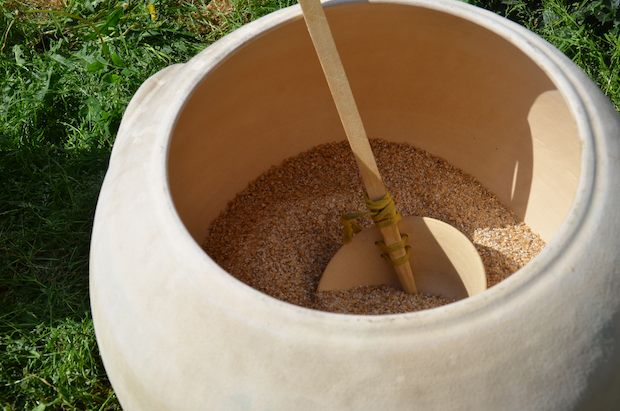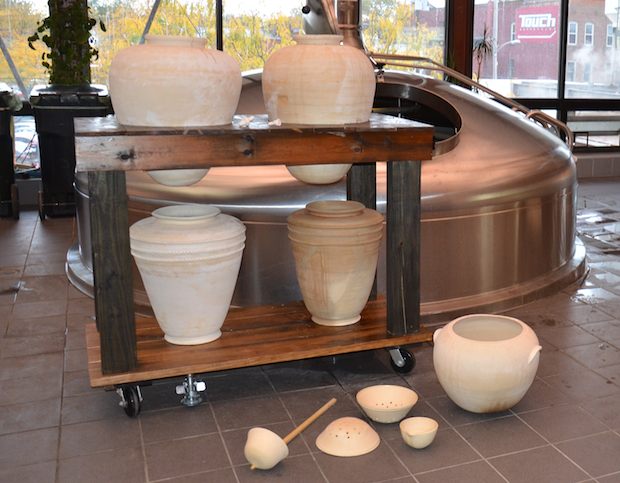
Four millennia separate these beer brewing technologies. Cleveland-based Great Lakes Brewing Company used a 4,000-year old recipe taken from a song lyric to the goddess Ninkasi and brewed it in ceramic pots replicating technology of the era. (Credit: GLBC.)
It’s been a long time since I’ve done an “adult beverage” post. Maybe I was just waiting for the right confluence of things to hook me.
So I was completely hooked when I finally caught up with a New York Times article that hit a triple point for me—beer; Cleveland, Ohio; and ceramics.
Great Lakes Brewing Company, a Cleveland-based microbrewery since before those were trendy, is working with archaeologists from the University of Chicago to recreate a 4,000-year-old recipe for Sumerian ale using traditional Sumerian equipment and methods. The equipment consisted of a ceramic pot and a wooden spoon. Sumeria was in the Mesopotamian region that today is Iraq.
Below is what the GLBC website says about the project. (Warning: GLBC “cards” visitors before granting access to the website.)
“For the past year, Great Lakes Brewing Company’s brewers and archaeologists at the University of Chicago Oriental Institute have painstakingly attempted to create an authentic version of an ancient Sumerian ale. Using only rudimentary tools like ceramic pottery and wooden sticks, our brewers developed a version of the liquid referenced in the earliest known beer “recipe”: the Hymn to Ninkasi, which was carved into clay tablets by the Sumerians in 1,800 BC.”
Scholars at the University of Chicago have been studying the ancient beer for some time, according to this newsletter (pdf) from 1991. See p. 2 for a translation of the song to the goddess Ninkasi that includes the recipe and some clues to the brewing process.
Last week the brewery held a tasting event featuring the ancient beer recipe made using ancient methods—a ceramic double-pot system—and the same recipe using modern brewing techniques. (The tasting event sold out in only 48 hours. While the Sumerian ale won’t be available to the rest of us, I can highly recommend GLBC’s modern offerings!) According to a Cleveland Plain Dealer article, the brew was rather sour and thick, apparently more like a porridge than a liquid. One attendee described its taste as “Sumerian vinaigrette.” So maybe the recipe needs some tweaking—after all, poetic song lyrics may not provide the most rigorous of documentation.
But the recipe and raw materials are just part of the art. Processing matters, too, and we know that equipment, tools, and technique impact outcome. The hymn to Ninkasi says little about equipment, referring vaguely to a “fermenting vat” and a “large collector vat.” Thankfully, the University of Chicago archaeologists have more than a little knowledge in this regard, and the GLBC turned to Brian Zimerle, a “preparer” at UC’s Oriental Institute, for an assist on making the necessary vats.
Zimerle used about 800 pounds of clay to make a collection of 25 gal. fermenting vessels, 20 gal. collecting vessels, and 10–15 gal. mashing vessels. His first challenge was to find a clay that somewhat replicated clays the Sumerians would have used. “Many of the local clays that were used for the bulk of pottery production in Mesopotamia throughout its history, including the period for the brewing vessels, were often a marl clay, or a coarse claybody that contained a fair amount of calcium carbonate or decomposed limestone etc., which is not desirable in commercial clay,” Zimerle says in an email. He found a Chicago-area supplier of a buff stoneware clay that was close in composition, but “the chemical composition was still off in a lot of ways,” he admits.
Zimerle also had to modify the clay with organic material for the pots that would be exposed to heat during brewing to encourage porosity and thermal durability. “The clays used in Mesopotamia were also fairly coarse and would also have a variety of organic temper added, such as chaff or straw,” he explained. Vessels were fired to cone 01–1 (about 1150°C), consistent with literature reports of firing parameters from the era. The fired surface, he says, vitrified enough to hold liquid.
To construct the pots, “I tried to stay close to what would have been equivalent at the time, and from what the archaeological evidence seems to indicate would be the most probable method,” Zimerle says. “The pottery wheel would have been in use by this time, although it would be utilized as a simple ‘fast’ wheel at best or a slow turning wheel (practically a turntable or banding wheel).” Zimerle used his electric motor-driven wheel at slow speeds “equivalent to having an assistant turning the wheel by hand.”
He took the time to add some simple rope decorations to the collecting vessels (see image above), so they are beautiful as well as functional. But, I’ll admit, the modern-day engineer in me thinks the stainless steel brewing tanks behind them are beautiful, too.
If happy hour is part of your plan for this late summer afternoon, lift a toast to our ancient brethren and their nascent brewmaking skills!

